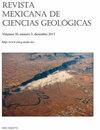Fires and volcanic activity: History of fire in the Mexico basin during late Pleistocene based on carbonized material records in the Chalco lake
IF 0.5
4区 地球科学
Q4 GEOSCIENCES, MULTIDISCIPLINARY
Revista Mexicana De Ciencias Geologicas
Pub Date : 2019-07-28
DOI:10.22201/CGEO.20072902E.2019.2.1090
引用次数: 5
Abstract
Forest fires, considered as free and not programmed fire propagation, are perturbations that greatly alter ecosystems. During fires, variable quantities of charcoal particles are produced by the burning vegetation, which can be later deposited in lacustrine basins. The traditional charcoal size particle model associates the > 100 µm primary particles to local fire events, within the watershed, and the < 100 µm particles are linked to regional fire events, outside the watershed. Fires can be related with favorable climatic conditions, but in tectonically active areas like the basin of Mexico, volcanism can also be a factor producing fires and charcoal particles. We document the history, intensity and frequency of fires recorded in the lacustrine sediments of lake Chalco (core CHAVII-11), by performing a high-resolution charcoal particle analysis in sediments deposited before and after three main volcanic events. The sources of these events had different distances to lake Chalco: Tláhuac tephra (TTH; 28690 years cal BP), probably produced by the Teuhtli volcano, was a local event; the Tutti Frutti Pumice (PTF; 17000 years cal BP) produced by the Popocatépetl volcano, was an extra-local event and the Upper Toluca Pumice (PTS; 12300 years cal BP) produced by the Nevado de Toluca volcano, was a regional event. Charcoal accumulation rates (CHAR) and distribution of size particles indicate that paleoclimate was a direct factor defining the intensity and recurrence of fires before and after volcanic activity, as climate defines vegetation type and density, and therefore fuel availability. Fires before and after the TTH were frequent, local and intense in comparison with fires reconstructed before or after the PTF and PTS events. CHAR values were lower during the more widespread PTF event, than for the local TTH event, although the highest CHAR values were recorded for the most distant, regional, and intense PTS event. These results show that charcoal accumulation rates during the volcanic events in central Mexico cannot be interpreted following traditional model of charcoal particle dispersion. This model have important restrictions in active volcanic regions such as central Mexico.火灾和火山活动:基于查尔科湖碳化物质记录的更新世晚期墨西哥盆地火灾史
森林火灾被认为是自由的、非程序性的火灾传播,是极大地改变生态系统的扰动。在火灾期间,燃烧的植被会产生大量的木炭颗粒,这些颗粒后来会沉积在湖盆中。传统的木炭大小颗粒模型将>100µm的初级颗粒与流域内的局部火灾事件相关联,而<100µm颗粒与流域外的区域火灾事件相联系。火灾可能与有利的气候条件有关,但在墨西哥盆地等构造活跃地区,火山活动也可能是产生火灾和木炭颗粒的因素。我们通过对三次主要火山事件前后沉积的沉积物进行高分辨率木炭颗粒分析,记录了Chalco湖湖泊沉积物(核心CHAVII-11)中记录的火灾历史、强度和频率。这些事件的来源与Chalco湖的距离不同:Tláhuac tephra(TTH;28690年cal BP),可能由Teuhtli火山产生,是一个局部事件;Popocatépetl火山产生的Tutti Frutti浮冰(PTF;17000年cal BP)是一个额外的局部事件,Nevado de Toluca火山产生的Upper Toluca浮冰(PTS;12300年cal BP。木炭堆积率(CHAR)和大小颗粒的分布表明,古气候是决定火山活动前后火灾强度和复发的直接因素,因为气候决定了植被类型和密度,从而决定了燃料的可用性。与PTF和PTS事件前后重建的火灾相比,TTH前后的火灾是频繁的、局部的和强烈的。在更广泛的PTF事件期间,CHAR值低于本地TTH事件,尽管在最遥远、最区域和最强烈的PTS事件中记录了最高的CHAR值。这些结果表明,墨西哥中部火山活动期间的木炭积累率不能按照传统的木炭颗粒分散模型来解释。这种模式在墨西哥中部等火山活动地区有重要的限制。
本文章由计算机程序翻译,如有差异,请以英文原文为准。
求助全文
约1分钟内获得全文
求助全文
来源期刊

Revista Mexicana De Ciencias Geologicas
地学-地球科学综合
CiteScore
1.00
自引率
12.50%
发文量
0
审稿时长
6-12 weeks
期刊介绍:
Revista Mexicana de Ciencias Geológicas (RMCG) publishes original research papers on geological processes of broad interest, and particularly those dealing with regions of Latin America. The RMCG also publishes review papers on topics of current interest, and on the geology and tectonics of geological provinces of Latin America. Besides, it offers the opportunity for host editors to publish special thematic issues.
 求助内容:
求助内容: 应助结果提醒方式:
应助结果提醒方式:


